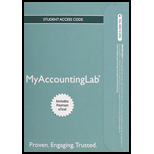
Concept Introduction:
Total Liabilities:
Total liabilities can be defined as the sum or the total of short-term i.e. current liabilities and long-term i.e. long-term liabilities. The short-term and long-term liabilities are the debts or obligations which needs to be paid on a later decided date.
Long-term debt:
Long-term debt can be defined as the obligations which are needed to be paid after 12 months or 1 year.
Debt to equity:
Debt to equity can be defined as a ratio that measures a company’s financial leverage. It is calculated by dividing total liabilities to total shareholder’s equity.
Debt to equity is calculated as under –
Requirement 1
How much was Starbucks Corporation’s Long-term debt at September 29, 2013
Requirement 2
To compute:
Debt to equity ratio at September 29, 2013
Want to see the full answer?
Check out a sample textbook solution
Chapter 14 Solutions
MyLab Accounting with Pearson eText -- Access Card -- for Horngren's Accounting
- Solve this Accounting MCQ 375arrow_forwardFinancial accounting 34.67.89arrow_forwardSuppose that Ken-Z Art Gallery has annual sales of $900,000, cost of goods sold of $590,000, average inventories of $176,000, average accounts receivable of $109,000, and an average accounts payable balance of $54,000. Assuming that all of Ken-Z s sales are on credit, what will be the firm's cash cycle? (Use 365 days a year).arrow_forward
- Computer equipment was acquired at the beginning of the year at a cost of $72,450, with an estimated residual value of $3,250 and an estimated useful life of 6 years. Determine the second-year depreciation using the straight-line method.arrow_forwardI need help finding the accurate solution to this general accounting problem with valid methods.arrow_forwardKindly help me with this General accounting questions not use chart gpt please fast given solutionarrow_forward
- Corp uses the allowance method to account for uncollectible receivables. At the beginning of the year, Allowance for Bad Debts had a credit balance of $1,300. During the year, Corp wrote off uncollectible receivables of $2,500. Corp recorded a Bad Debts Expense of $3,500. What is Corp's year-end balance in Allowance for Bad Debts?arrow_forwardneed help this questionarrow_forwardWhat is the book value of the company if thearrow_forward

 AccountingAccountingISBN:9781337272094Author:WARREN, Carl S., Reeve, James M., Duchac, Jonathan E.Publisher:Cengage Learning,
AccountingAccountingISBN:9781337272094Author:WARREN, Carl S., Reeve, James M., Duchac, Jonathan E.Publisher:Cengage Learning, Accounting Information SystemsAccountingISBN:9781337619202Author:Hall, James A.Publisher:Cengage Learning,
Accounting Information SystemsAccountingISBN:9781337619202Author:Hall, James A.Publisher:Cengage Learning, Horngren's Cost Accounting: A Managerial Emphasis...AccountingISBN:9780134475585Author:Srikant M. Datar, Madhav V. RajanPublisher:PEARSON
Horngren's Cost Accounting: A Managerial Emphasis...AccountingISBN:9780134475585Author:Srikant M. Datar, Madhav V. RajanPublisher:PEARSON Intermediate AccountingAccountingISBN:9781259722660Author:J. David Spiceland, Mark W. Nelson, Wayne M ThomasPublisher:McGraw-Hill Education
Intermediate AccountingAccountingISBN:9781259722660Author:J. David Spiceland, Mark W. Nelson, Wayne M ThomasPublisher:McGraw-Hill Education Financial and Managerial AccountingAccountingISBN:9781259726705Author:John J Wild, Ken W. Shaw, Barbara Chiappetta Fundamental Accounting PrinciplesPublisher:McGraw-Hill Education
Financial and Managerial AccountingAccountingISBN:9781259726705Author:John J Wild, Ken W. Shaw, Barbara Chiappetta Fundamental Accounting PrinciplesPublisher:McGraw-Hill Education





